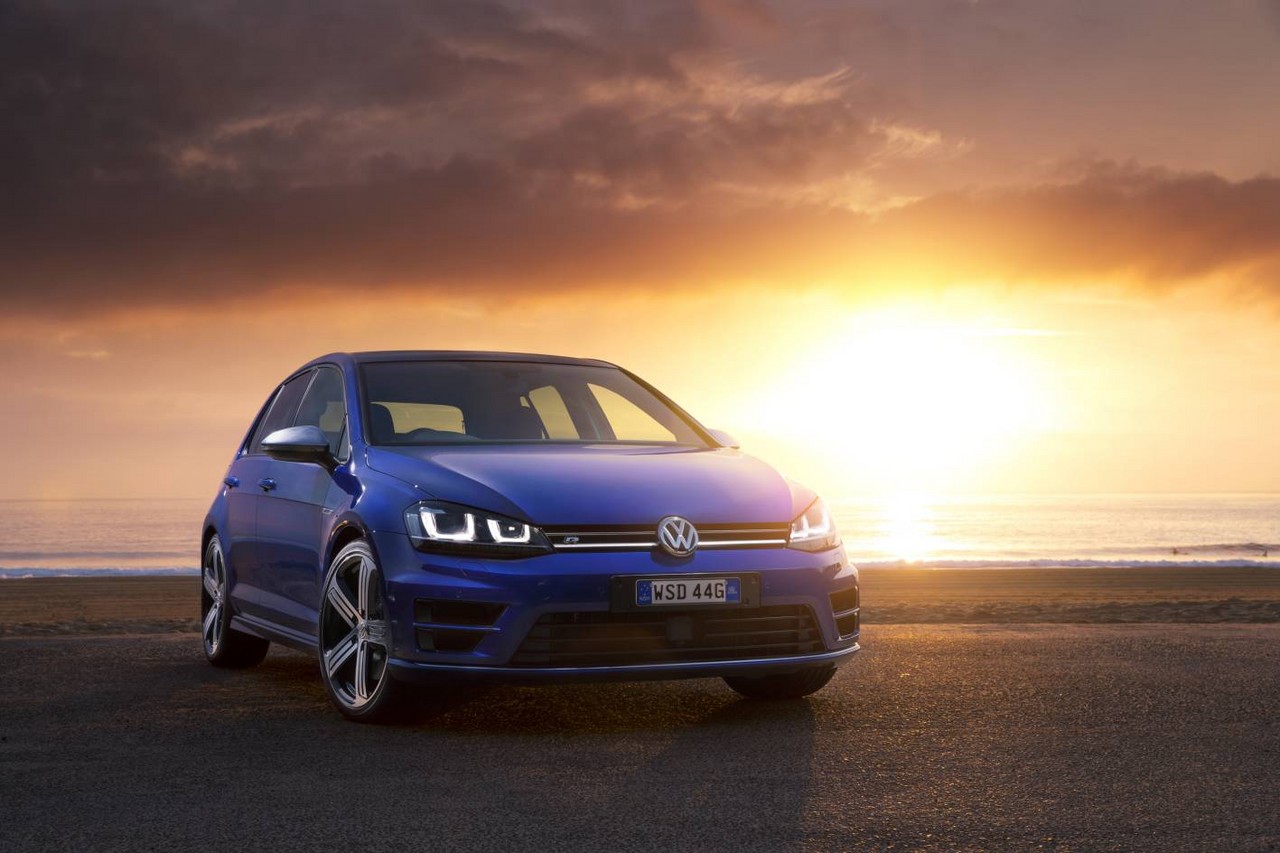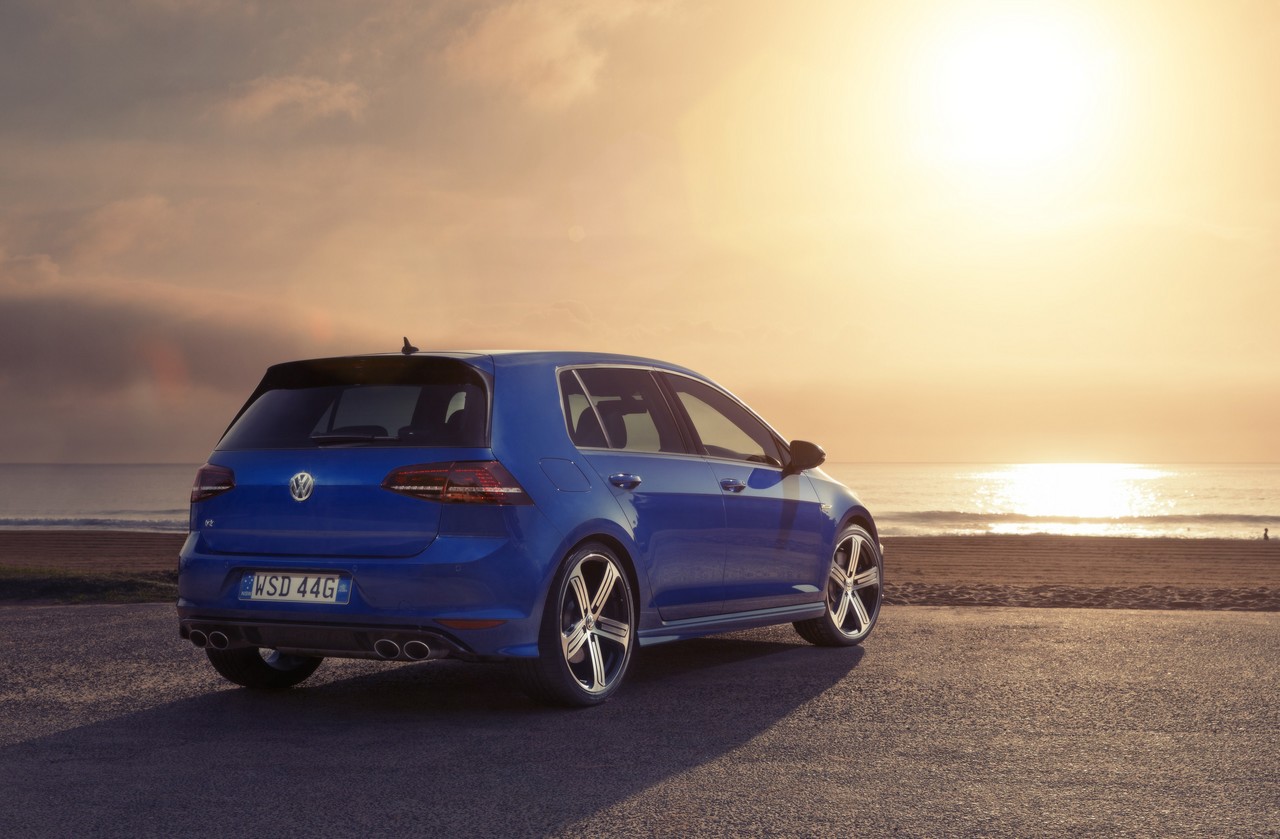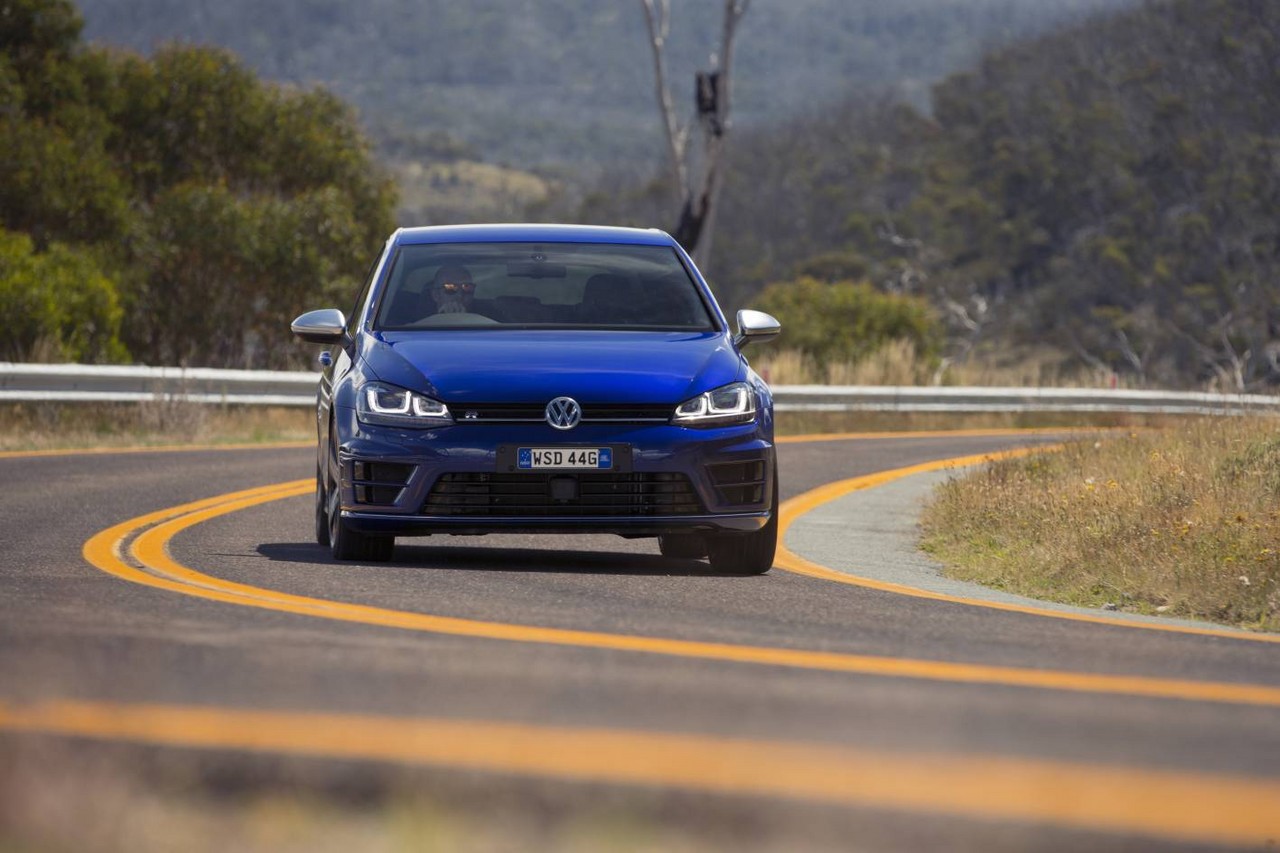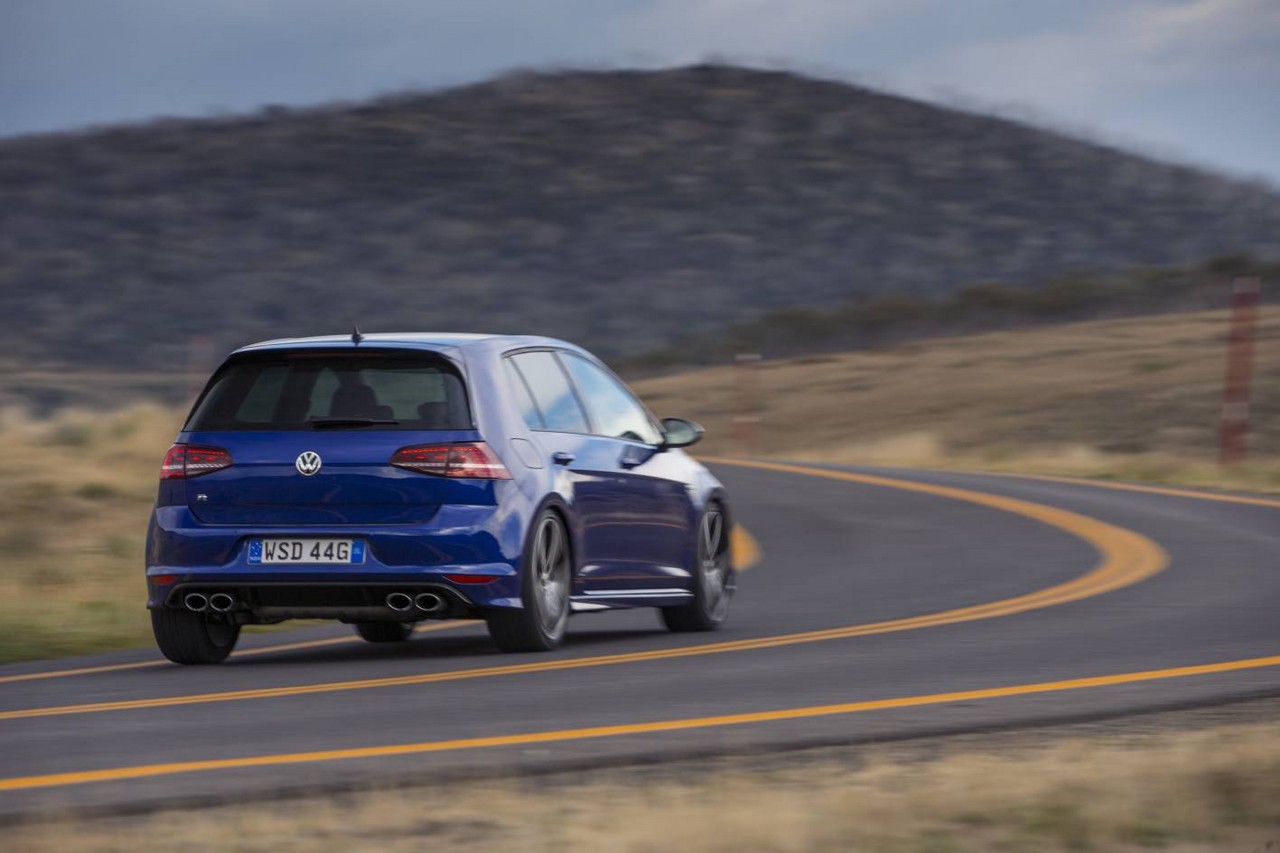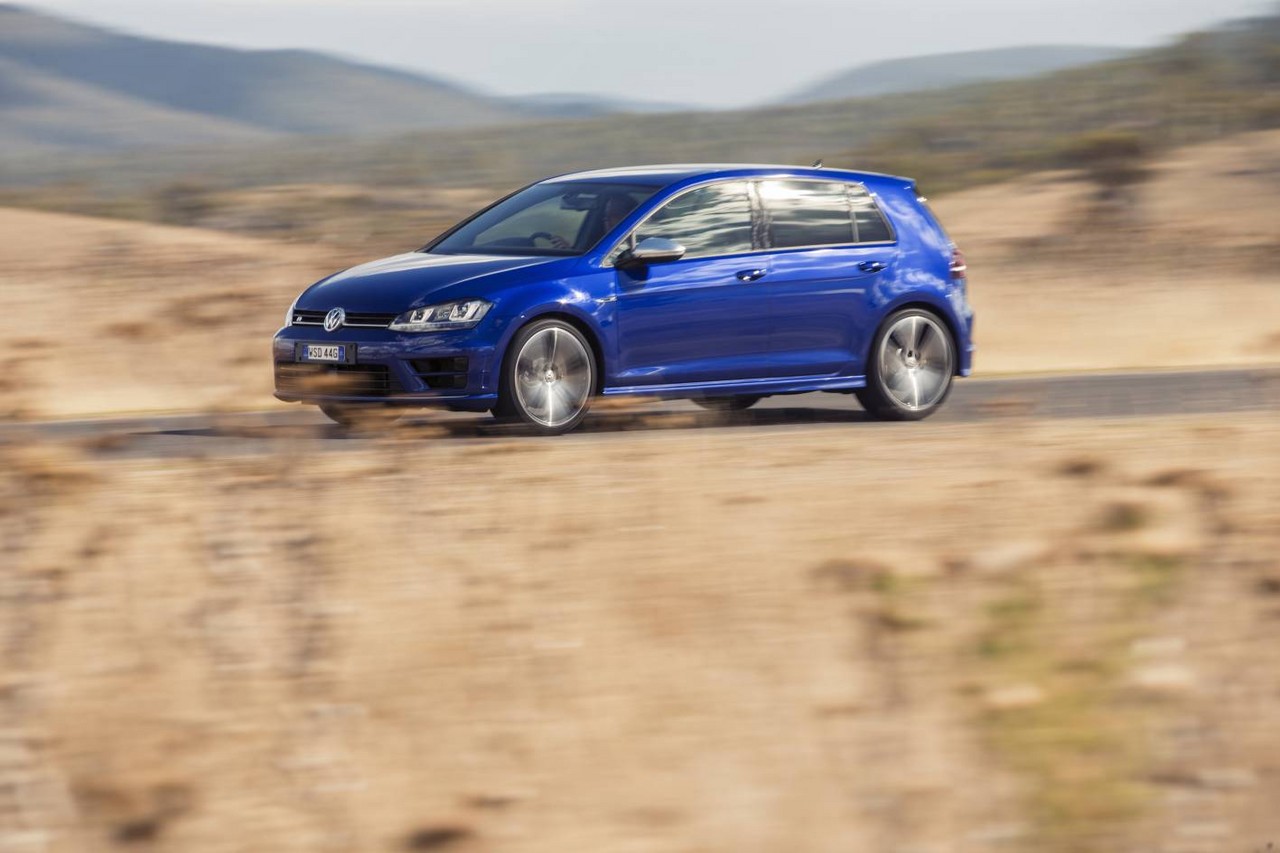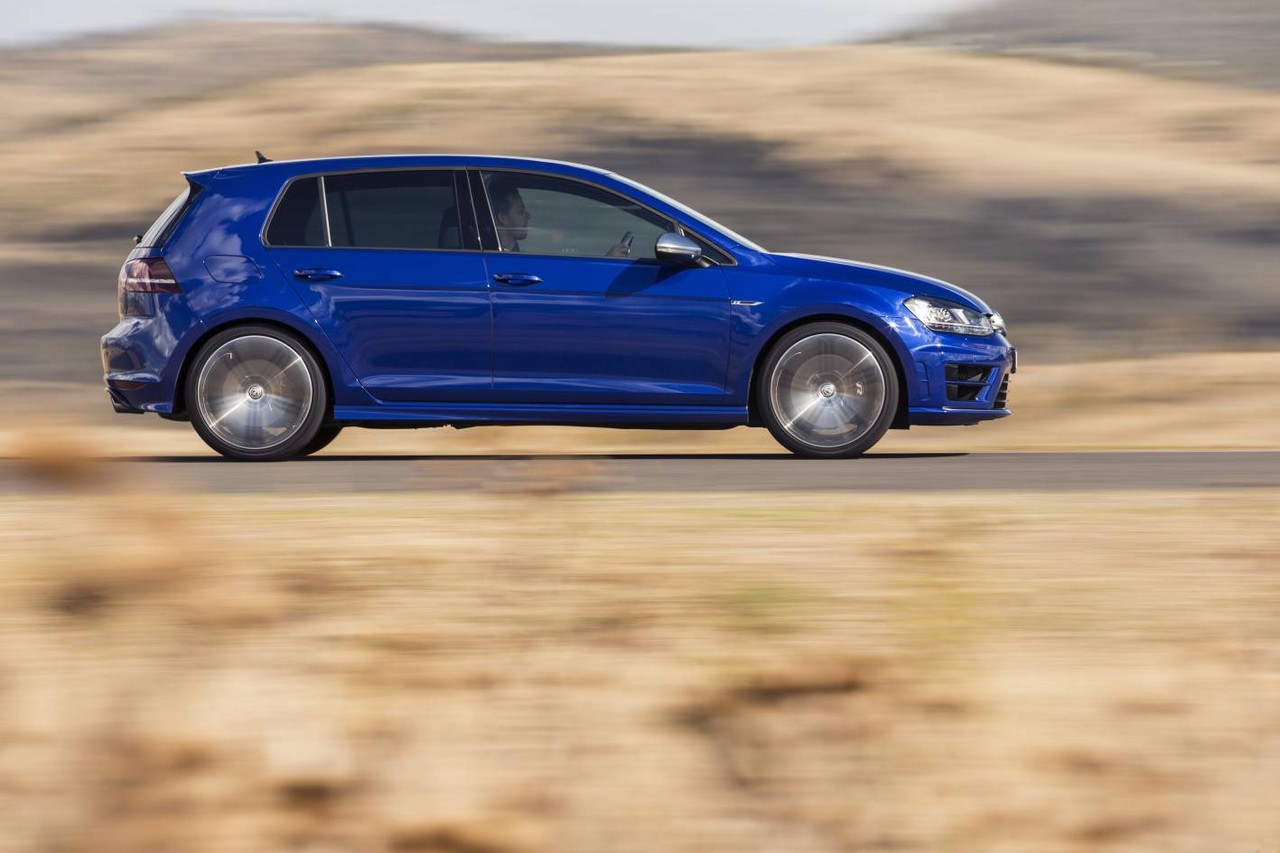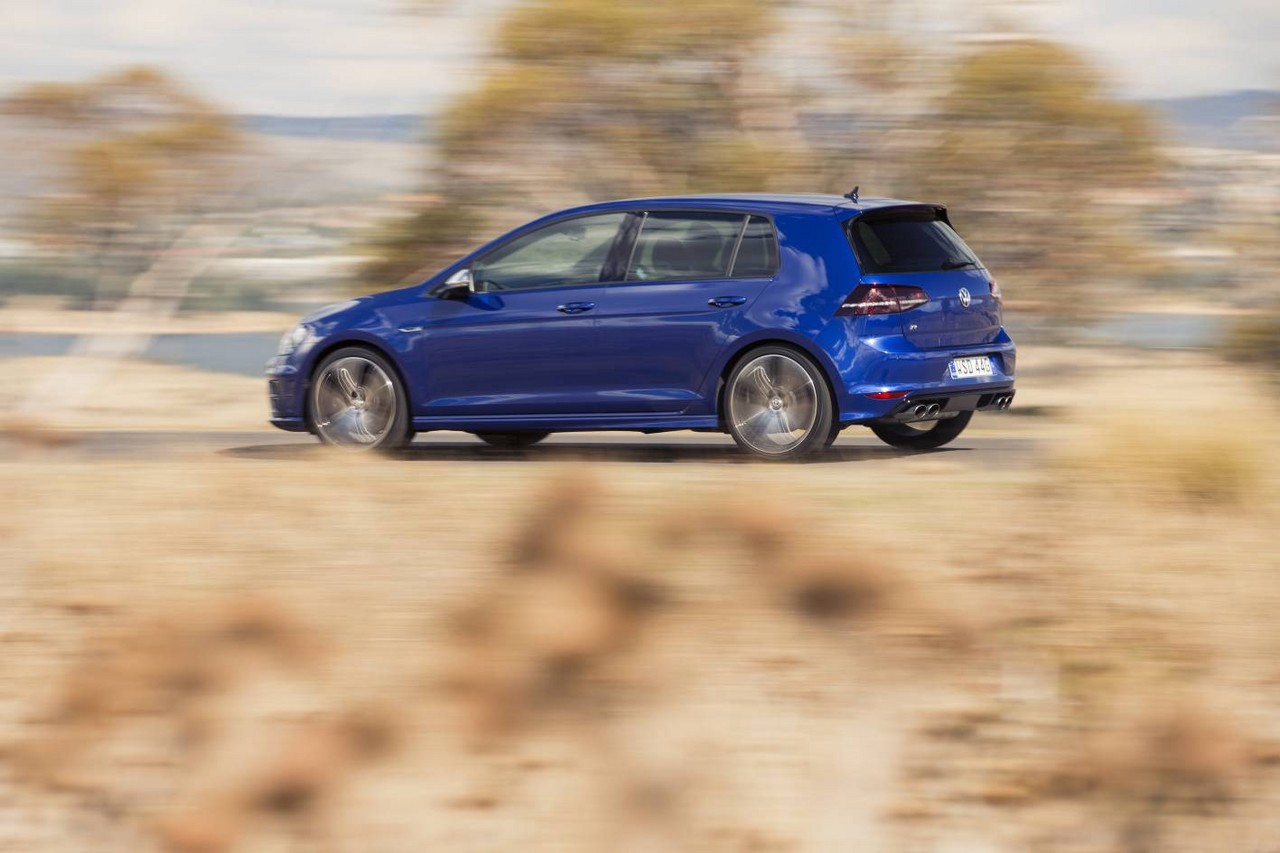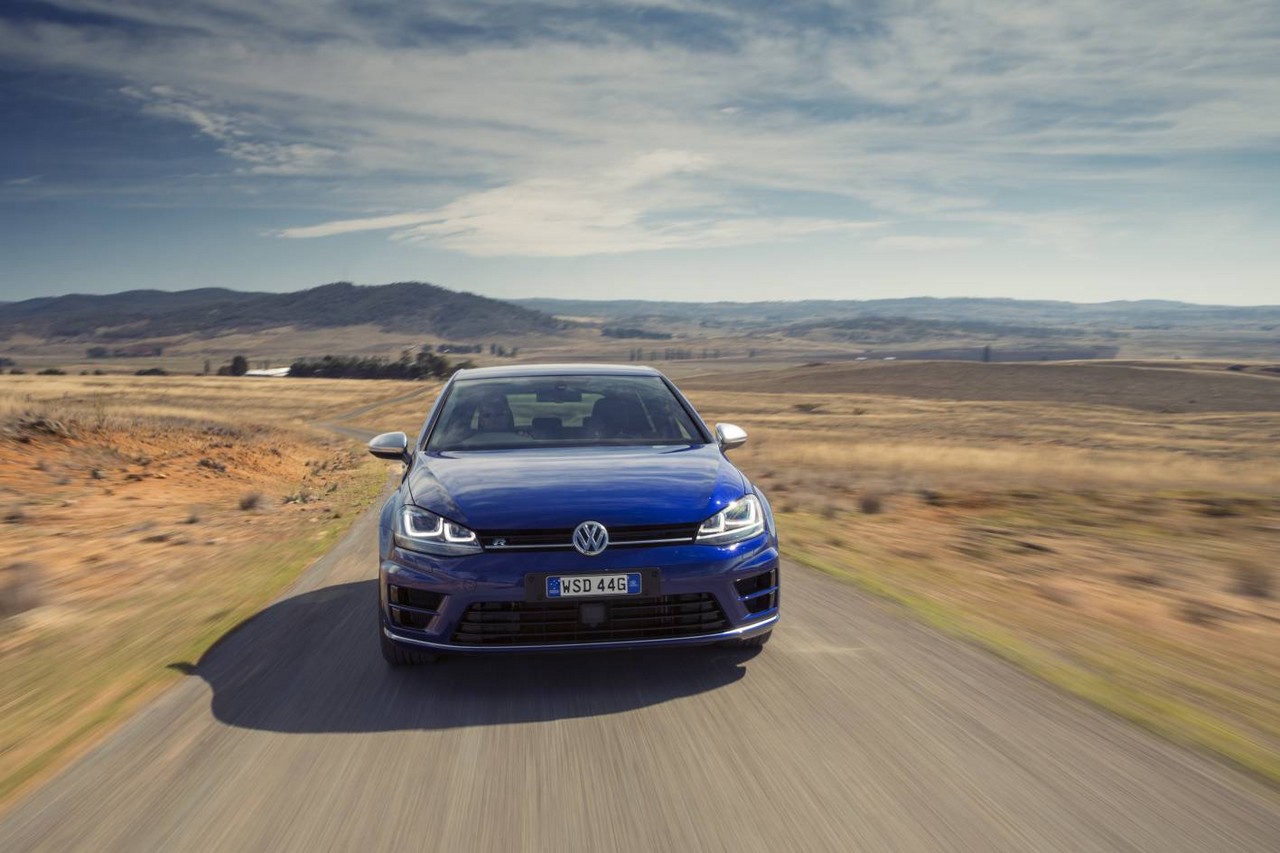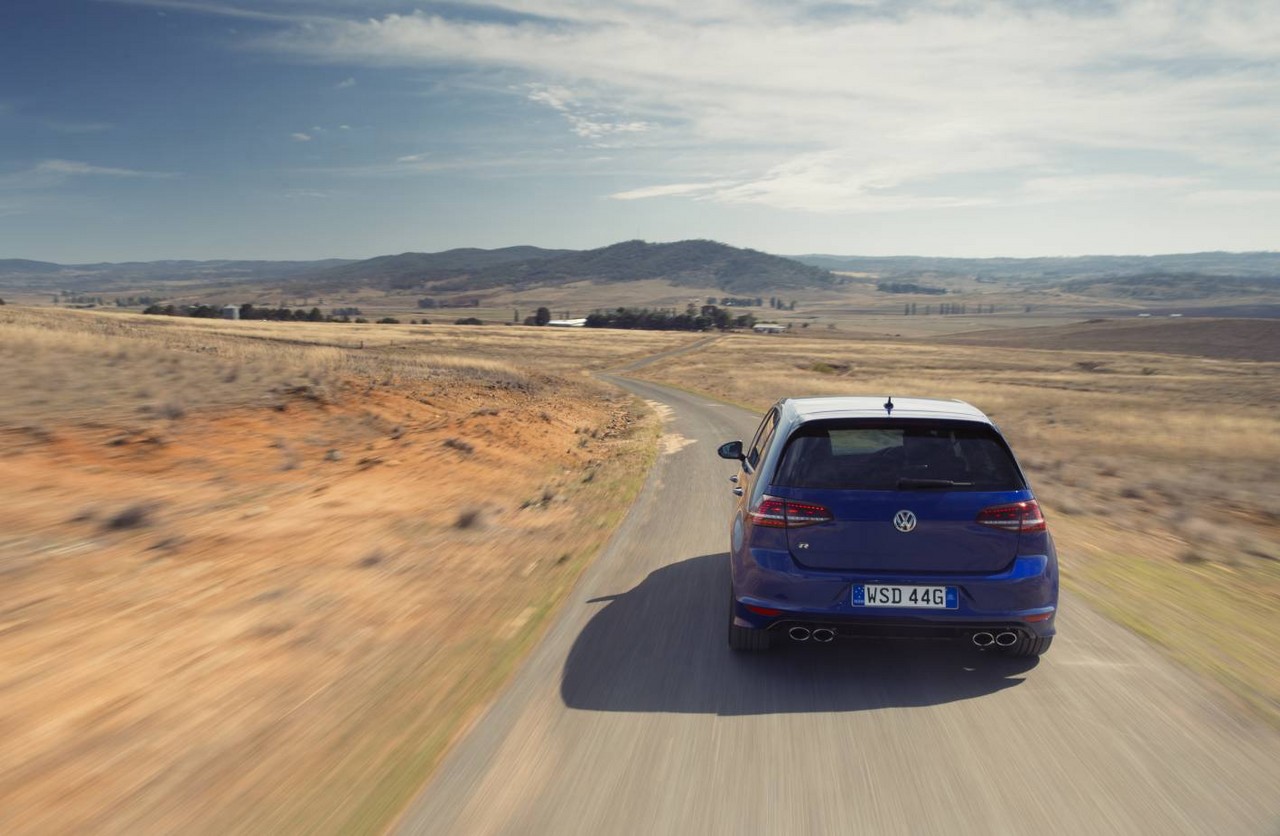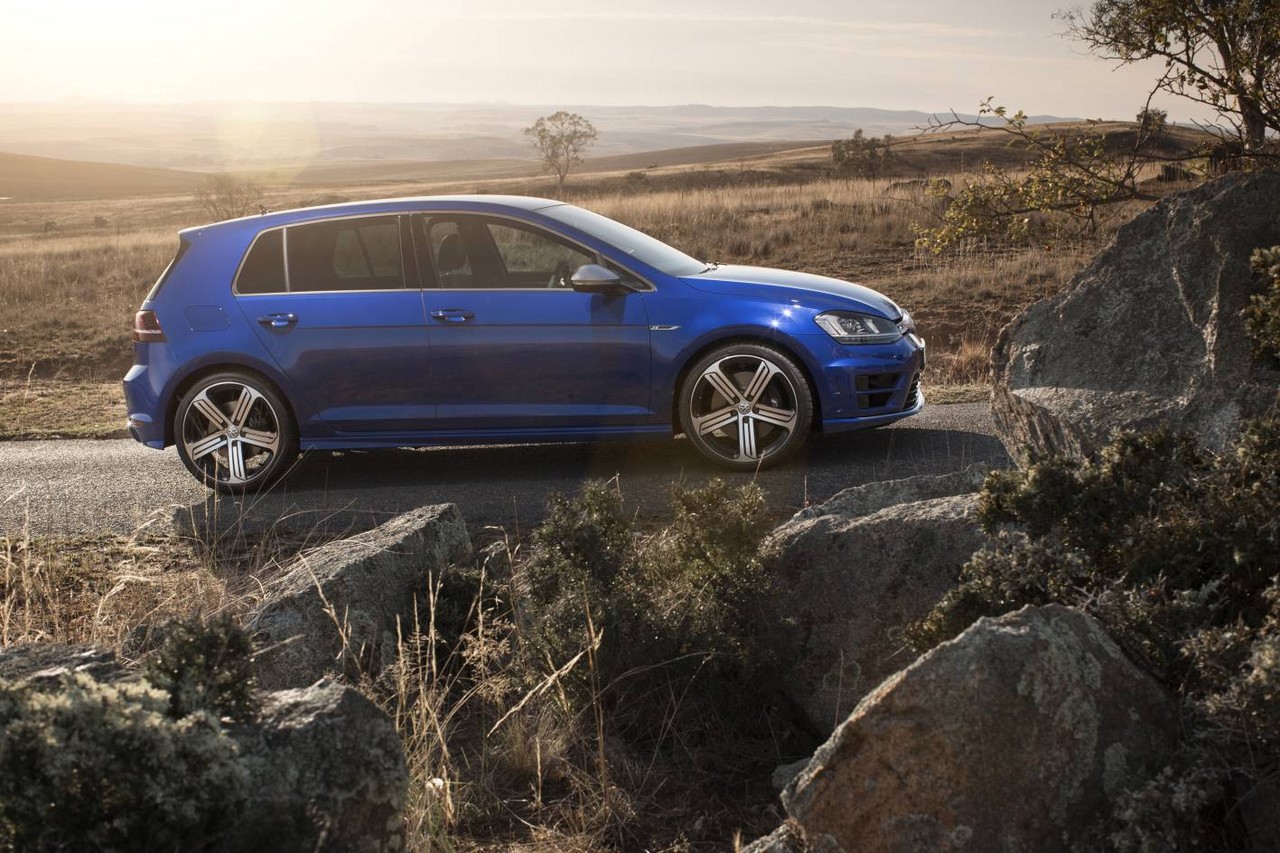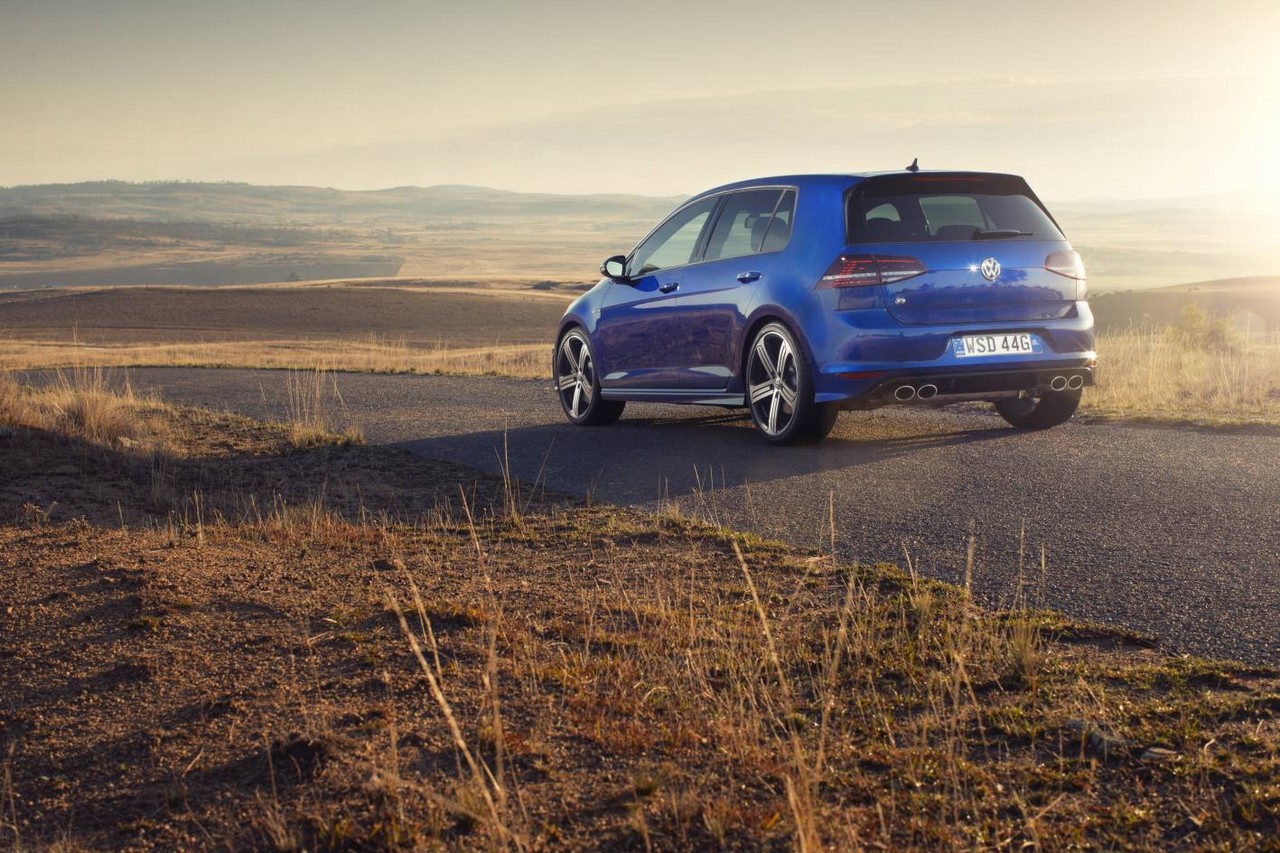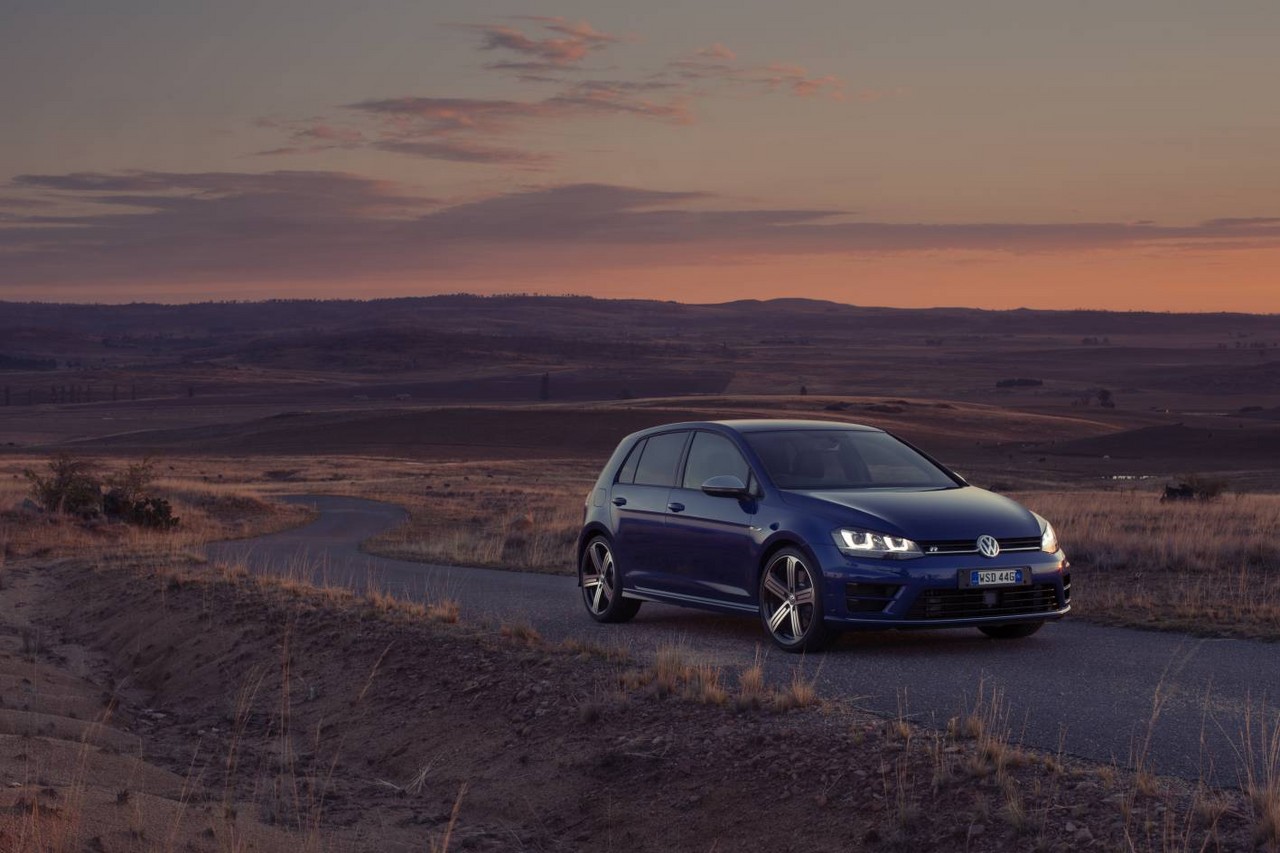
- Powerful 2.0-litre turbo petrol engine
- Fast gearshifts from Volkswagen’s DSG
- Excellent dynamics
- Adaptive suspension provides impressive compliance
- Accurate, well-weighted steering provides good feedback
- Some turbo lag (particularly when compared to VW Mk.7 Golf GTi )
- DSG hesistant when accelerating from rest
- Turbo failure for pre-October 2014 Golf R models
Overview
Released in Australia in April 2014, the Volkswagen Mk.7 Golf R was a five-door hatchback. Manufactured in Wolfsburg, Germany, the all-wheel drive VW Mk.7 Golf R was powered by a 2.0-litre turbocharged petrol engine that was mated to a six-speed double clutch transmission (DCT or Volkswagen’s ‘DSG’).
EA888 Gen 3 engine
The Mk.7 Golf R was powered by Volkswagen’s 1984 cc CJXB EA888 Gen 3 four-cylinder petrol engine which had a grey cast iron block with an 82.5 mm bore and a 92.8 mm stroke, a die-forged steel crankshaft with five main bearings, a cast aluminium alloy cylinder head, an IHI turbocharger which provided peak boost pressure of 1.2 bar (17.4 psi), an intercooler, double overhead camshafts driven by gear chains, variable intake and exhaust camshaft timing, two-stage variable exhaust valve lift, four valves per cylinder actuated by roller finger cam followers and a compression ratio of 9.3:1.
Compared to the Mk.7 Golf GTi and GTi Performance CCHA and CHHB engines , changes for the Golf R’s CJXB engine included:
- A revised cylinder head (including the exhaust valves, valve seats and springs;
- Modified pistons;
- High-pressure injection valves; and,
- A larger IHI turbocharger.
The Golf R could accelerate from rest to 100 km/h in 5.2 and 5.0 seconds with the manual and DSG transmissions, respectively. Furthermore, the Golf R required 98 RON premium unleaded petrol (PULP).
| Engine | Trans. | Peak power | Peak torque | |
|---|---|---|---|---|
| Golf R | 2.0-litre CJXB turbo petrol I4 | 6sp man., 6sp DCT |
206 kW at 5100-6500 rpm | 380 Nm at 1800-5500 rpm |
DSG transmission
The transversely mounted DSG unit had two wet clutches, two input shafts and two outputs shafts. In this arrangement, Clutch 1 (C1) operated the odd gears (plus reverse), while Clutch 2 (C2) operated the even gears. When driving, the next-higher gear ratio could be engaged without actually being activated. To change gears, the clutch for the current gear would open and the other clutch (for the higher gear) would engage under electrohydraulic control. Since the opening and closing actions of the two clutches overlapped, Volkswagen claimed that the system provided smooth gearshifts in less than four-hundredths of a second.
In addition to its fully automatic shift mode, the DSG had a Tiptronic function to permit manual gear selection – this could be performed via the steering wheel gearshift paddles.
Haldex 5 all-wheel drive (AWD) system
The Volkswagen Golf R was fitted with a fifth-generation Haldex all-wheel drive system which consisted an electronically controlled and hydraulically actuated multi-plate clutch coupling (located in front of the rear axle differential at the end of the prop shaft). Under low loads or when coasting, the rear axle was decoupled to reduce fuel consumption. If, however, there was a loss of front wheel traction or such a loss was anticipated by on-board sensors, then an electrohydraulic oil pump would apply pressure to the clutch plates to transfer up to 50 per cent of the engine’s torque to the rear wheels (for a 50:50 front:rear torque split).
Extended Electronic Differential Lock (XDL)
The Golf R was fitted with an ‘Extended Electronic Differential Lock’ (Volkswagen’s ‘XDL’). When cornering, the XDL responded to the unloading of the front inside wheel by applying the brakes to that wheel to prevent wheelspin and minimise understeer.
Dimensions
Compared to the Volkswagen Mk.7 Golf GTi , the Golf R was 4 mm shorter (at 4264 mm), 24 mm lower (1442 mm) and had a 6 mm shorter wheelbase (2620 mm), though width (1799 mm) was unchanged. Cargo capacity was 343 litres with the rear seats in position, though this increased to 1233 litres when they were folded flat.
Suspension
The Volkswagen Mk.7 Golf R had MacPherson strut front suspension with lower A-arms and an anti-roll bar, while the independent four-link rear suspension had coil springs and an anti-roll bar. The Golf R was also fitted with electronically-controlled, adaptive dampers (Volkswagen’s ‘Adaptive Chassis Control’) which could vary damping resistance according to road conditions. With Adaptive Chassis Control, the driver could also select from Normal, Comfort and Sport settings which also altered throttle response and steering weight.
Steering
The Volkswagen Mk.7 Golf R had electric, speed-sensitive rack-and-pinion steering. For the Mk.7 Golf R, the steering had a progressive steering ratio such that the amount of steering wheel rotation required to turn the wheels decreased as steering lock increased.
Safety equipment
Standard safety equipment for the Mk.7 Golf R included dual front airbags, a driver’s knee airbag, front side airbags, full-length curtain airbags, ABS, electronic brake force distribution, brake assist, electronic stability control, traction control and front seatbelts with pretensioners and load limiters.
As standard, the Mk.7 Golf R was also fitted with:
- Fatigue Detection: monitored driver behavior at speeds in excess of 65 km/h for signs of fatigue. If the driver exhibited signs of fatigue, a tone would sound and a warning would appear in the multi-function display; and,
- Multi-collision brake: automatically braked the vehicle after a collision to reduce kinetic energy and minimise the likelihood of a second impact.
Driver assistance package (optional)
As an extra-cost option the Golf R was available with a ‘Driver assistance package’ which included:
- Adaptive Cruise Control (ACC): using a radar sensor, ACC could autonomously apply the vehicle’s brakes to maintain a preset distance to vehicle ahead. ACC could also cause the vehicle to accelerate to its pre-set speed after braking;
- Front Assist: Front Assist used a radar sensor to detect if the vehicle was closing too fast on the vehicle ahead. If this occurred, Front Assist would:
- provide audible and visual warnings to the driver,
- bring the brake pads into contact with the brake discs for an emergency stop; and,
- automatically apply the brakes to warn the driver.
- City Emergency Brake (City EB): at speeds below 30 km/h, City EB would monitor the road ahead for vehicles. If a collision was considered likely, City EB would prime the brakes and increase braking assistance. If the driver did not react and a collision was imminent, City EB would autonomously initiate emergency braking;
- Park Assist 2: could detect parallel parking space and provide automated steering for right angle and parallel parking; and,
- Proactive occupant protection system: in a potential accident situation, the seatbelts would be tensioned and windows closed.
If the driver failed to respond, Front Assist would apply the brakes automatically to avoid or reduce the severity a collision.
Brakes
Like the Mk.7 Golf GTi Performance , the Golf R had 340 mm by 30 mm ventilated front brake discs and 310 mm by 22 mm ventilated rear discs. For the Golf R, the brake calipers were painted black.
Euro NCAP testing
In Euro NCAP testing , the Mk.7 Golf received a five star safety rating which included a 94 per cent adult occupant protection rating and an 89 per cent child occupant protection rating. In the frontal offset crash test, occupant protection was generally assessed as good, though protection for the driver’s lower leg was rated as adequate. Maximum points were awarded in the side impact test though, in the more severe pole test, chest protection was rated as marginal and abdominal protection as adequate.
Under ANCAP’s assessment scheme , the Mk.7 Golf received a five star adult occupant protection rating with a score of 35.92 out of 37.
Features: Golf R
Like the Golf GTi Performance, standard features for the Golf R included Volkswagen’s ‘Discover Media’ audio and satellite navigation system with a 5.8-inch colour touch screen, eight speakers, CD player, MP3/WMA/ACC-compatibility, auxiliary inputs (SD card/3.5 mm/USB), Bluetooth mobile phone and audio streaming, dual-zone climate control air conditioning, front sports seats, cruise control with a programmable speed limiter, bi-xenon headlights with washers, integrated LED daytime running lights, a rear fog lamp, dark-tinted LED tail-lights, daytime running lights, front and rear parking sensors, a rear view camera with static guidance lines, automatic headlights, rain-sensing wipers, a leather-rimmed flat steering wheel, 40/60 split and folding rear seats, remote central locking, power windows, power adjustable and heated mirrors, automatic tilting of the passenger side mirror on reverse, a height and reach adjustable steering wheel, height adjustable front seats, an electromechanical parking brake, tyre pressure monitoring, two 12 volt power sockets (centre console and cargo area), an auto-dimming rear view mirror, a black roofliner, front LED reading lights, illuminated vanity mirrors, LED ambient lighting, stainless steel pedals, illuminated sill plates with aluminium finish, front and rear carpet mats, a cargo cover, tinted windows, tyre pressure monitoring, trip computer, an alarm and immobiliser.
The Golf R, however, was distinguished by its 19 x 8.0J ‘Cadiz’ alloy wheels with 235/35 R19 tyres, ‘Race’ cloth and Alcantara seat trim, proximity key (for keyless entry), push-button start, rear privacy glass, brushed aluminium pedals.
Visually, the Golf R could be identified by its gloss black inserts for the lower air intake and radiator grille, matte chrome finish door mirrors, exposed chrome exhaust pipes and rear bumper with gloss black diffuser.
MY16 Golf R
In July 2015, standard features for the Golf R were extended to include a 6.5-inch touchscreen (previously 5.8-inches), ‘App-Connect’ USB interface for enhanced smartphone connectivity (including access to Apple CarPlay, Android Auto and MirrorLink), Vienna leather upholstery and heated front seats.
Golf R Wolfsburg Edition
The Volkswagen Golf R Wolfsburg Edition released in Australia in July 2015. As standard, the Golf R Wolfsburg Edition was equipped with Volkswagen’s ‘Driver assistance package’ which included Front Assist with City Emergency Brake, Adaptive Cruise Control and a Proactive occupant protection system (see ‘Driver assistance package (optional)’, above, for details of these technologies). The Golf R Wolfsburg Edition was also fitted with a Blind Spot Monitor with rear traffic alert.
Inside, the Golf R Wolfsburg Edition featured ‘Carbon Nappa’ leather upholstery and individually heated front seats. Visually, the Golf R Wolfsburg Edition could be identified by its 19-inch ‘Pretoria’ black alloy wheels, black door mirror covers and a Wolfsburg crest badge. The Golf R Wolfsburg Edition was also available in an Oryx White Pearl paint finish.
Related links
- Press Kit: Volkswagen Mk.7 Golf R (April 2014)
- Specifications: Volkswagen Mk.7 Golf GTi and Golf R (April 2014)
- Specifications: Volkswagen Mk.7 Golf GTi and Golf R (September 2016)
- Wikipedia.org: Volkswagen Mk.7 Golf
